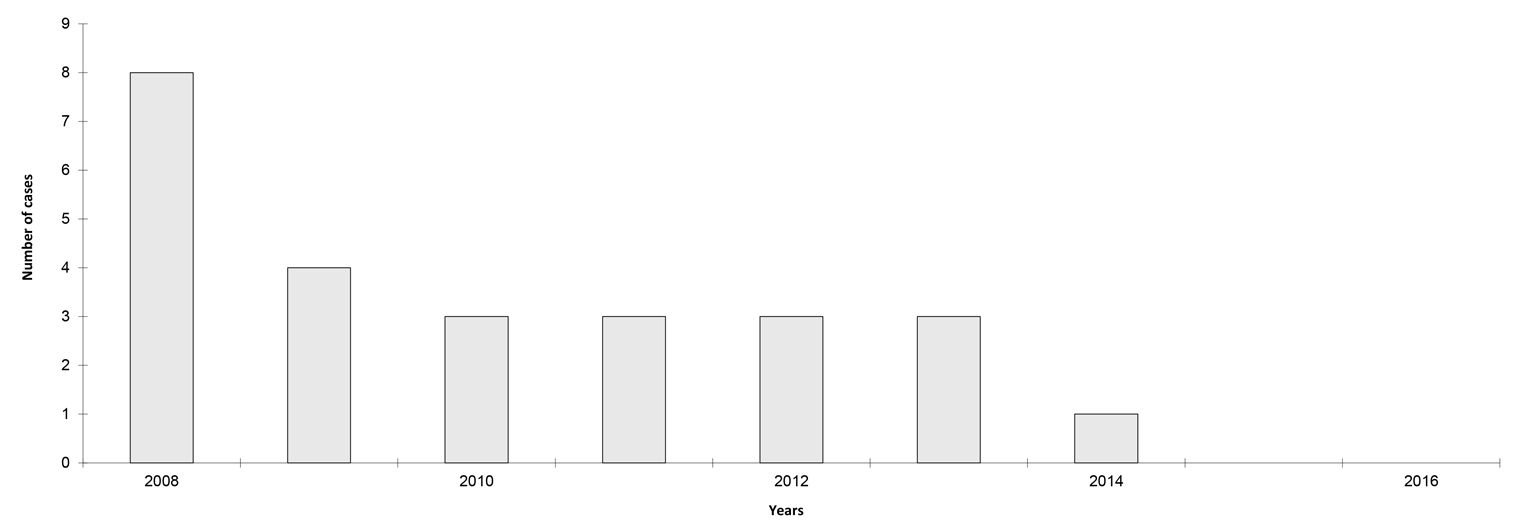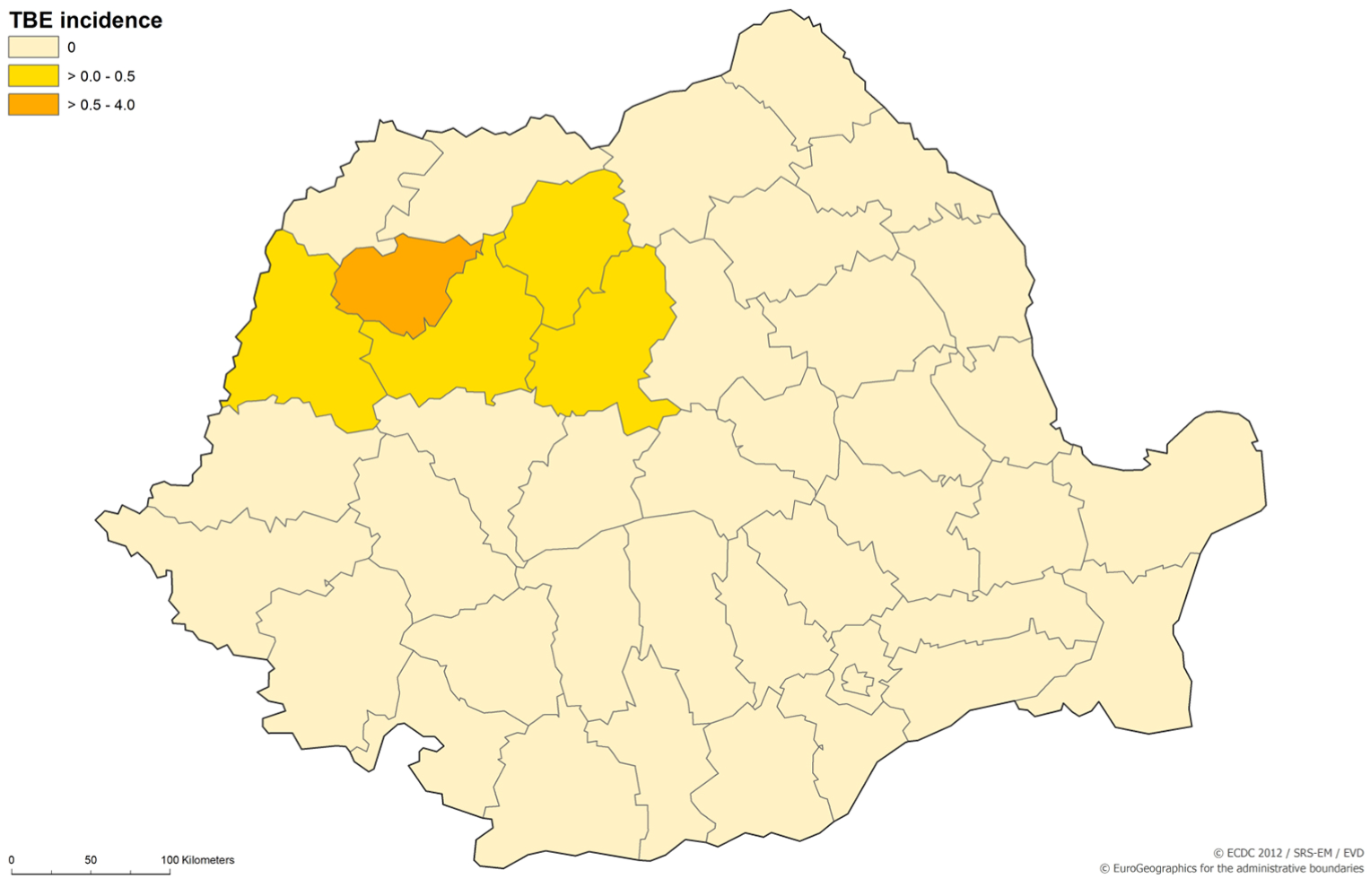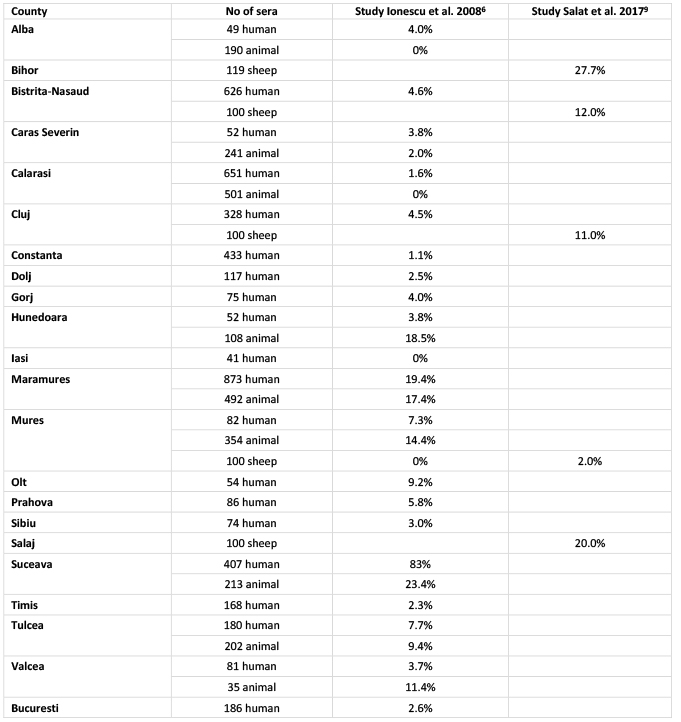Lidia Chitimia-Dobler, Adriana Hristea, Wilhelm Erber and Tamara Vuković-Janković
E-CDC risk status: endemic
(no new data available as of May 2023)
History and current situation
Based on an epidemiological survey,1 human TBEV neuroinfections may have an endemic emergent course, and natural foci are in full territorial expansion. Identified risk areas are Tulcea district, Transylvania, at the base of the Carpathian Mountains and the Transylvanian Alps.2,3 TBE has been a notifiable disease since 1996. Surveillance of TBE is not done at the country level, only regionally in some counties (northern/central/western part, close to Hungary). The passive surveillance system was implemented in 2008. However, there is no regular screening and the relative risk of contracting this disease is unknown. In 1999, an outbreak of TBE in humans was recorded with a total of at least 38 human cases.4 The probable cause of the outbreak was goat milk and raw goat milk products. Subsequent studies to detect TBEV in ticks in the affected regions resulted in a non -specified number of TBEV isolates, which were described as belonging to the European subtype of TBEV. A publication of the neighboring Republic of Moldova described the existence of the Far-eastern subtype of TBEV just at the border to Romania.5
In 2001–2006, an epidemiological survey of TBEV infection in 1,669 individuals from 11 Transylvanian counties showed a seroprevalence rate in the general population of 0.6%; higher rates were found in at-risk populations: 5.8% in those living around natural foci and up to 41.5% in those with known occupational risks.1,6
In 2008, a seroprevalence study was published testing 5,063 sera from humans and 2,336 sera from animals derived from a total of 20 counties all over Romania during the years 1985 to 1993. The overall sero-prevalence rate was found to be 6.5% for humans and 10.0% for animals with ranges from 0% to 19.4% for individual counties. The testing was done using hemagglutination inhibition testing without further confirmation by neutralization test.7 A recent prevalence antibody study published in 2017, which studied by serum neutralization test, 519 sheep samples from 5 Romanian counties provided a total seroprevalence rate of 15.2% with ranges from 2.0% to 27.7%. The data are summed up in Table 3.
During an unpublished study from 2011–2012, a total of 6,548 nymphs and 853 adult ticks of the species Ixodes ricinus from the Romanian counties Alba, Cluj, Ilfov, Mures and Sibiu, including the region of outbreak in 1999, were tested by real time-RT-PCR. All ticks were found to be negative. Testing of 74 sheep sera by TBEV neutralization test gave 6/60 (10%) sera from sheep from Sibiu county, while all other sera were found negative.7 In the same study the goat flock, which presumably caused the milk-borne outbreak in 1999 in the county of Sibiu was serologically tested by neutralization test. 10/10 (100%) goats of the flock showed positive antibody titers for TBEV.7
In the period between 2006–2015 the studies undertaken showed that the most frequent species of ticks in Romania is I. ricinus. Three Romanian counties were selected as ticks sampling sites (Sibiu, Tulcea and Giurgiu), collected from vegetation, livestock and reptiles. Specific RNAs from TBEV were detected (3’ UTR-genomic region) in <1% of I. ricinus pools.8
Overview of TBE in Romania
| Table 1: Virus, vector, transmission of TBE in Romania | |
|---|---|
| Viral subtypes, distribution | European subtype; possibly Far-Eastern subtype (?)1,5 |
| Reservoir animals | No data |
| Infected tick species (%) | I. ricinus – estimated prevalence of TBE virus <1%8 |
| Dairy product transmission | Outbreak in 1999 in Sibiu county with at least 38 human cases4 |
| Table 2: TBE reporting and vaccine prevention in Romania | |
|---|---|
| Mandatory TBE reporting | Since 2008 |
| Other TBE-surveillance | No data |
| Special clinical features | No data |
| Available vaccines | FSME-IMMUN |
| Vaccination recommendations and reimbursement | No national TBE vaccination policy and/or recommendations implemented |
| Vaccine uptake by age group/ risk group/ general population | Unknown |
| Name, address/website of TBE National Reference Center | Centrul de Prevenire si Control a Bolilor Transmisibile, Bucarest; https://cnscbt.ro/ |
Figure 1: Burden of TBE in Romania over time7

| Year | Number of Cases | Incidence / 105 |
|---|---|---|
| 2008 | 8 | 0.04 |
| 2009 | 4 | 0.02 |
| 2010 | 3 | 0.01 |
| 2011 | 3 | 0.01 |
| 2012 | 3 | 0.01 |
| 2013 | 3 | 0.01 |
| 2014 | 1 | 0.00 |
| 2015 | 0 | 0.00 |
| 2016 | 0 | 0.00 |
| 2017 | ||
| 2018 | ||
| 2019 | ||
| 2020 | 0 | 0.00 |
| 2021 | No data | |
| 2022 | No data |
Figure 2: TBEV-isolation and TBE cases in Romania

Contact:
lydiachitimia@gmail.com
Citation:
Chitimia-Dobler L, Hristea A, Erber W, Vuković-Janković T. TBE in Romania. Chapter 12b. In: Dobler G, Erber W, Bröker M, Schmitt, HJ, eds. The TBE Book. 6th ed. Global Health Press;2023. doi: 10.33442/26613980_12b26-6
References
- Molnar GB, Perseca T, Feder A, Pacuraru D, Marialaki E, Cojan A. Epidemiological assessment of morbidity and natural foci of TBE-CEE virus infection in Transylvania. Rev Med Chir Soc Med Nat Iasi. 2008;112:471-77.
- Kollaritsch H, et al. Background document on vaccines and vaccination against tick–borne encephalitis. Geneva, WHO Strategic Advisory Group of Experts on Immunization. Available at: http://www.who.int/immunization/sage/6_TBE_backgr_18_Mar_net_apr_2011.pdf [Accessed May 2017]
- Suss J. Tick-borne encephalitis in Europe and beyond–the epidemiological situation as of 2007. Euro Surveill. 2008;13(26). pii: 18916.
- Ionescu L, Alexse A, Ceianu C, Necsulescu M, Popescu D, Bicheru S, Dumitrescu G, Cumpanasoiu CE, Cumpanasoiu C, Pasat L, Tirziu E. Investigation methods used for identifying the presence of tick-borne encephalitis virus (TBEV) in vector arthropods. Lucr Stiin Med Vet. 2009;17(9):288-93.
- Ponomareva EP, Mikryukova TP, Gori AV, Kartashow MY, Protopopova EV, Chausov EV, Konovalova SN, tupota NL, Gheorghita SD, Burlacu VI, Ternovoi VA, Loktev VB. Detection of Far-Eastern subtype of tick-born encephalitis viral RNA in ticks collected in the Republc of Moldova. J Vector Borne Dis. 2015;52:334-6.
- Ionescu L, Necsulescu M, Alexse A, Ceianu C, Popescu D, Bicheru S, Ordeanu V; Nicolescu G, Vladimirescu AL, Postoarca A. Infection with tick-borne encephalitis virus in Romania (in Romanian). Rev Rom Med Vet. 2008;3:69-79.
- Kahl O, Chitimia-Dobler L, Süss J. unpublished data
- Vladimirescu A, Dumitrescu G, Ionescu L, et al. Real-Time PCR studies regarding the borrelia burgdorferi, francisella tularensis, tick borne encephalitis virus (TBEV) and crimeean congo hemorrhagic fever virus (CCHFv) occurrence in the Romanian ticks. Int J Infect Dis. 2016;45S:193.
- Salat J, Mihalca AD, Mihaiu M, Modrý D, Ruzek D. Tick-borne encephalitis in sheep, Romania. Emerg Infect Dis. 2017;23:2065–7.
- Zavadska D, Anca I, André F, Bakir M, Chlibek R, Cižman M, Ivaskeviciene I, Mangarov A, Mészner Z, Pokorn M, Prymula R, Richter D, Salman N, Simurka P, Tamm E, Tešović G, Urbancikova I, Usonis V. Recommendations for tick-borne encephalitis vaccination from the Central European Vaccination Awareness Group (CEVAG). Hum Vaccin Immunother. 2013;9:362–74.
